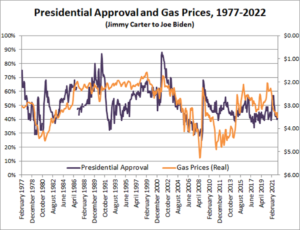In “Biden States Will Decide Who Controls the Senate,” Ronald Brownstein writes at CNN Politics,
The one silver lining for Democrats on an otherwise stormy political horizon may be the map of states with competitive Senate races this fall.
All of the Senate contests both sides consider the most competitive will be in states that Joe Biden won in 2020, albeit in most cases narrowly.
That geography could provide a critical boost for beleaguered Democrats in an era when both parties are finding it more difficult to win Senate races in states that usually vote the other way for president. That dynamic has grown so powerful that each party now holds just three of the 50 Senate seats in the 25 states that voted against their presidential candidates in the 2020 election.
None of the three Democratic senators in states that then-President Donald Trump won in 2020 is on the ballot this fall, which leaves the battlefield centered overwhelmingly on terrain Biden captured. But Biden’s eroding job approval numbers could undermine that potential geographic advantage. Each side has won very few 21st-century Senate races, either with incumbents or for open seats, in states where the approval rating is lagging for a president of its party.
Brownstein quotes Democratic pollster Celionda Lake, who worked for presidential candidate Biden in 2020: “It’s not just a referendum on Biden. In Senate races you have the resources to make it a real choice; it doesn’t have to be a derivative choice of an affirmation of the president or not.”
Bronwnstein adds, “Unless Biden can get a second wind before November, especially in states that he won, the Democrats’ chances of holding the Senate will turn on whether she’s right.” He notes that ticket-splitting is more of a rarity in recent elections: “Just 1 in 6 people split their votes between presidential and Senate races in the 1990s, according to [Alan I.] Abramowitz’s calculations. The number of split-ticket voters, though oscillating somewhat from election to election, has fallen even further during presidential contests in this century, frequently dropping to only about 1 in 10.” Further,
The numbers were even more dramatic after 2020: Republicans now hold 94% of the seats in the states that voted for Trump two times. (That reflects their hold of 47 of the 50 Senate seats in the 25 states he carried in 2020, since all of them also voted for him in 2016.) Twenty states voted against Trump both times: Democrats now control 98% of their Senate seats — all but the one held by Republican Sen. Susan Collins of Maine.
The remaining five states — Arizona, Georgia, Michigan, Pennsylvania and Wisconsin — flipped from supporting Trump in 2016 to backing Biden in 2020. Democrats now hold eight of their 10 Senate seats.
Bronwstein argues that the GOP’s “chances are best against Democrat Catherine Cortez Masto in Nevada, a state Trump lost only narrowly each time, but Republicans also believe they can threaten New Hampshire’s Maggie Hassan and even Colorado’s Michael Bennet if a big enough red wave develops.”
None of the three Democratic senators in states Trump won in 2020 “Montana’s Jon Tester, Ohio’s Sherrod Brown and West Virginia’s Joe Manchin — is up for reelection this fall. All might have faced very difficult odds in this political environment.” But Republicans are investing heavily in winning back seats held by Democratic Sens. Mark Kelly (AZ) and Raphael Warnock (GA), both of whom are running for a six-year term. Worse,
The clear message of midterm elections in this century is that Biden’s approval rating will cast a huge shadow over the contests in all three of these categories. In 2018, for instance, Republicans lost all 10 of the Senate races in states where Trump’s approval rating registered at 48% or below, according to the exit polls conducted by Edison Research for a consortium of media organizations including CNN.
Similarly, in the 2014 midterm elections, Democrats lost 14 of the 15 Senate races in states where Obama’s approval rating stood at 42% or less, according to the exit polls. In 2010, Democrats likewise lost 13 of the 15 where Obama stood at 47% or less. In 2006, Republicans lost 19 of the 20 Senate races in states where President George W. Bush’s job approval stood at 45% or less.
Those are scary precedents for Democrats, because Biden’s approval ratings are lagging in the key states on the Senate map. Recent public polls show his job approval at 43% in Wisconsin and between 35% and 40% in Georgia, New Hampshire and Florida. On a slightly different metric, only 3 in 10 described his performance as excellent or good in a recent Pennsylvania poll.
Brownstein notes “occasional exceptions, such as Collins’ victory in 2020 in a state Biden won comfortably, or the 2018 victories of Democratic Sens. Manchin, Tester and Brown in states where Trump’s approval rating in the exit polls exceeded 50%.” Also, “A January Quinnipiac poll in Georgia, for instance, put Warnock’s approval rating there 11 percentage points higher than the President’s — and a striking 15 points better with independents.”
Democrats shouldn’t expect much midterm benefit from Trump’s troubles, Brownstein believes. But Republicans have “flawed candidates who are stuck in vicious expensive primaries that will drain their resources and leave their eventual nominee badly out of step with the voters that decide the general election in their states,” as David Bergstein, communications director for the Democratic Senatorial Campaign Committee, says. Brownstein calls this is “a real risk for the GOP particularly in Arizona, Colorado, North Carolina, Ohio and Pennsylvania.”









